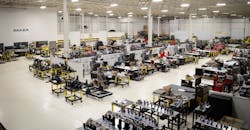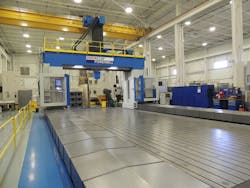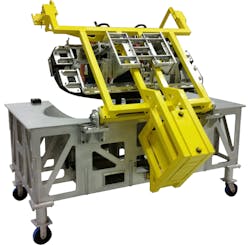Once again, I’ve taken to the road. My last trip was to Vermont to see some of the manufacturing around Burlington. This time I had the opportunity to see how Michigan is spurring economic growth through manufacturing and innovation. The Michigan Economic Development Corporation (MEDC) sponsored the trip; its mission is to market Michigan and provide the tools and environment needed to drive jobs and create investments.
The Motor City has obviously had its fair share of problems over the years. However, when asking various local businesses why they came to Detroit, or stayed in Detroit, one answer was heard over and over again: Detroit has a large talent pool. At a time when skilled labor is in high demand, moving to where the talent concentration is can’t hurt.
In the modern age of manufacturing, both the aerospace and automotive industries are embracing new materials, technologies, and ideas. With a deep history in both industries, Michigan is a breeding ground for innovation. This series of articles will walk through my trip to Detroit, and see why the future of the automotive and aerospace industries are in Michigan.
Baker Industries houses the only Mecof PowerMill in the U.S. This machining giant is one of the largest and most versatile milling centers in the Midwest.
My first night in Detroit, I saw a thriving downtown area with public transportation and some great restaurants. After I sat down with members of MEDC and the Development Counsellors International (DCI; a leader in marketing places, and organizer of this trip), I asked Otie McKinley, media and communications manager at MEDC, what he considered the best way to revive an economy. Incentives and industry diversification were two areas he cited.
However, you don’t just give money away. Many of Detroit’s business have earned their keep with proven growth that has decreased unemployment and boosted the economy. The first company we visited was automotive and aerospace manufacturer Baker Industries. The company has shown incredible growth for more than 25 years. Kevin and Scott Baker started out in 1992 with three employees and a few used machines in a 2,100-sq.-ft. corner of a building they rented. Twenty-six years later, Baker Industries has more than 280 employees and four plants totaling more than 220,000 square feet of space.
Despite its proximity to the automotive talent pool, Baker eventually diversified into other industries, such as the aerospace sector. This helped them keep the machines turning and workers employed even during the automobile industry’s bankruptcy and bailouts.
In addition to referencing MEDC, Baker mentioned the Procurement Technical Assistance Centers (PTACs) of Michigan. PTACs are not-for-profit organizations made up of 11 offices located throughout Michigan. Their mission is to enhance national defense and economic development in the state by assisting Michigan businesses in obtaining and performing on federal, state, and local government contracts. Through seminars, events, training, and consultations, they work to help local businesses succeed in the government marketplace.
Baker utilizes 3D printing in order to cut down on project lead time and help customers save in material costs. Decreased tool weight due to hybrid tooling has a positive impact on employee safety.
With some history and business out of the way, we started touring the facility. Not only were there a lot of milling machines around, but also several large machines. I had never seen five-axis machines this large. Unfortunately, a lot of the cool tools were used in aerospace and defense contracts, so I couldn’t take pictures.
Entering the building, there were just aisles of machines all working hard. I asked them how they know when to invest in new equipment. “Experience,” the guide answered. “We’ve been doing this for 25 years.” Walking into another building I only saw a few machines. However, the machines were the size of the room; among them was the Emco Mecof PowerMill. With a load capacity of 2.6 million lb. across the table, it has an envelope of X – 45 ft, 11 in. by Y-19 ft, 8 in. by Z—10 ft, 2 in. My guide said it is currently one of the largest milling centers in the Midwest region and the only Mecof PowerMill in the U.S.
The last building on the tour housed seven 3D printers, including metal and plastic machines. 3D printing is what has helped Baker continue to stay at the forefront of innovation and new technology. It’s given them the unique advantage of integrating additive and traditional manufacturing technologies to achieve optimal speed to market, weight reduction, operating cost, quality, and functionality. I noticed there were some EOS and Stratasys industrial printers. When I asked, “Why EOS and Stratasys?” the tour guide simply said that these industrial machines offered the precision and tolerances they needed.
Baker Industries is a strong company that has weathered Detroit’s economic storms only to grow its technology and capability. This company is proof that modern manufacturing isn’t a dark dirty shop, but a high-tech industry that is constantly evolving. In addition, Baker Industries is one of the many companies that prove Motor City has the talent and adaptability necessary to keep Detroit moving.
In Part 2, I tour Roush Performance and Wedoo. Roush is known for its racing performance parts that has been stacking up awards and racing trophies since 1970. Then I meet Wedoo, an international digital company that offers virtual and augment reality software to stitch together research, technology, creativity, and business.



